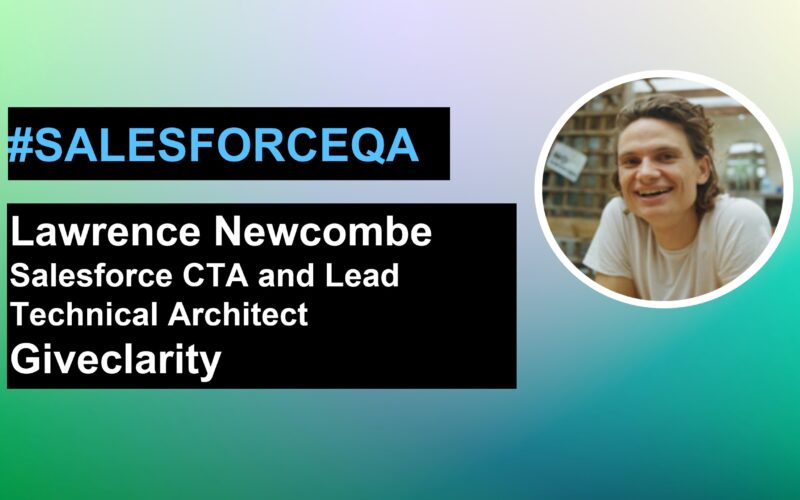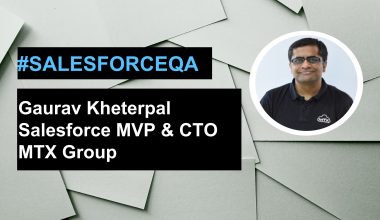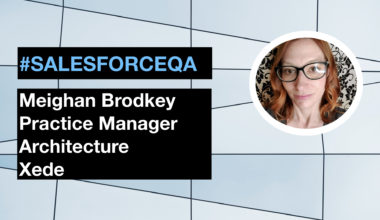In our most recent #SalesforceQA, we caught up with Lawrence Newcombe, Salesforce CTA and Lead Technical Architect at Giveclarity.
Lawrence talks about his app FormulaShare, and offers advice to others looking to develop an app for the platform.
Lawrence also highlights top tips for Salesforce CTA preparation, check them out below!
Salesforce Republic (SR): To start, could you tell us a bit about your career journey and what inspired you to work in the Salesforce ecosystem?
Lawrence Newcombe (LN): I found my way to Salesforce somewhat accidentally. I was working as a BA for a large broadcaster and really wanted to move into the non-profit sector doing something related. I applied for a job at Voluntary Service Overseas (VSO) who were just starting a transformation programme to embed Salesforce.
Although I’d worked with CRMs to manage interactions with advertisers, I’d never seen Salesforce. I was blown away by how quickly we could develop and adapt the system with simple configuration. New fields, layout changes, reports… These were things I was used to briefing in to skilled development to get implemented. Having this control as a BA, and being able to offer this to end users, closes so many inefficiencies in the build process.
Over the next 9 years I gained more implementation, development, design and architecture experience at VSO and other organisations – working on a really big rollout at NCS Trust helped me to understand how the platform can be implemented effectively at scale, things like multiple development workstreams, CI/CD processes, analytics tooling and marketing automation.
Very recently I’ve started a role as a Lead Technical Architect at Giveclarity.org, a Salesforce partner focusing on charities which need fundraising solutions. This is a really common use case in the sector but not one I’ve had much exposure to, so I’m really excited to build up my experience in this area.
SR: What advice would you give to other Trailblazers who are looking to pursue a career in the non-profit sector?
LN: Most organisations need the same kind of skills as profit-making companies, and all need committed people to contribute to their work – firstly know that many of the technical and soft skills you have from private sector experience are highly valued by non-profits too. Knowing NPSP or having sector experience can help but are very rarely expected.
Many non-profits have Salesforce implementations managed by partners who focus on the sector, so finding out who these are and investigating careers with them is a great first step – the Salesforce.org registered partner pages (Find a partner and Find a partner international) are a good place to start. Clients with the biggest orgs will often recruit Salesforce talent through the same channels they use for other roles, so keep an eye on sector-specific jobs boards too. And Salesforce recruiters know open positions better than anyone – let them know you’re looking exclusively within the sector and they will be in a great position to help.
SR: Becoming a CTA is a difficult task, what is something you know now that you wish someone had told you before you started the journey to CTA?
LN: Just what an engaged and supportive community there is. This is truer today than when I took CTA, with several community-organised study groups open to those who’ve earned the pre-requisite exams and are committed to the next stage.
It’s the gap between what’s expected to pass pre-requisite exams and what’s expected to pass the CTA board which has historically been the most mysterious. These groups are really helping to build a community with a collective understanding of what’s needed for the board, and mean having a specific highly-experienced mentor (which I was lucky enough to have) is no longer essential.
If you’re considering CTA, do join the Architect Trailblazer’s group. From there you’ll be able to find and get connected with the best community organised groups.
SR: Do you have any top tips for CTA preparation?
LN: Find ways you can shape your day job to always learn new sides of the platform. Are you usually the expert in code solutions? Ask to be engaged more deeply in business analysis and functional work. Want to understand more around DevOps tooling? Set up a pilot using free tools or trial accounts and demo what’s possible to your team. There aren’t many people with expert knowledge in every area of the platform and everyone going for CTA will have areas they just need to study hard to know, but the wider your breadth of experience the fewer of these there will be and the easier job you’ll have.
One side of the platform I struggled with in my preparations was OAuth and Single Sign On (SSO) flows – CTA judges will generally expect you to know the mechanics of these areas very well. During the final few months before my board I collated notes and diagrams for the flows Salesforce support, and shared these with the architect community. This led to some great dialogue and many others collaborated to improve these resources. I published the improved versions as a resource for future CTAs and anyone else interested in identity and security.
SR: As the demand for Salesforce professionals continues to increase, in your opinion, what are the key things Trailblazers should consider when looking for a new role?
LN: It’s a candidate’s market so use this to your advantage! Be ambitious, consider carefully what you’re looking for and be really open to employers about what this is. Change in role? More seniority? Flexible working? Exposure to a new technology? Now is the perfect time to align your career and working environment around what’s important to you.
SR: Do you have any advice for standing out during the interview process?
LN: Think about ways you can demonstrate your passion for your role outside of work. Show you have interest in Salesforce or technology through blog posts, speaking at events, building something, answering questions on the Stack Exchange or just about anything else! Things like this are rarely expected but can make a big impact in showing your commitment to what you do.
SR: You also have an app on the AppExchange, FormulaShare, could you talk us though the process of creating this app/any advice you have for others?
LN: Sure, FormulaShare came about after seeing sharing models in different organizations which couldn’t be easily implemented on core platform. Situations like “share this custom object with staff from the country record it’s linked to”. FormulaShare lets you create sharing rules which are much more flexible than the native equivalents in Salesforce.
The core codebase of FormulaShare is open source, and there’s a completely free version of the tool on the AppExchange for addressing these use cases, check it out here! I’m also in the process of finalising an Enterprise version of the app which will support more sophisticated rules and include ways to optimize for data volumes of larger orgs, which should be available soon.
If you’re working on implementations regularly but you’d like to develop your own app, pay close attention to anything you’re doing more than once. If you’re repeatedly solving similar problems for clients then there might well be appetite for an app to help. The beauty of working with Salesforce is the skills needed to develop an app are very similar to what’s needed to configure the core platform, so you may find you have 90% of the knowledge you need already!
SR: Finally, what’s the best piece of advice you’ve received throughout your career in the ecosystem?
LN: Certifications and career development are for you and not for your company or organisation. One of the many supportive things my manager said to me while I was getting ready for CTA is “This is your thing, you don’t need this for your job”. Certifications become much less stressful and more enjoyable when you see them in this way.
If you’re a Salesforce professional and would like to join Lawrence in our Q&A series, please get in touch with us today!


